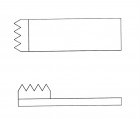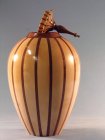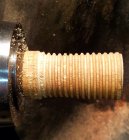I'm watching John Berkeley number 1 dvd on thread chasing. It's finally available! It was out of production for quite a few years. A company in Texas is selling them again. On the video, John uses a "16 TPI Whitworth" hand tap to make a thread on a little hole on a box lid. He then uses a 24 TPI male chaser to create a little-threaded rod. The little-threaded rod is to hold a small flower for the top of the lid, with, of course, threads.
Question is: If a 16 Whitworth TPI tap goes with a 24 tpi chaser, what tap goes with a 16 tpi chaser? Also, I have a 20 tpi chaser, amongst others, but I want to use my 20 tpi to hold the flower. What tap do I buy for the 20 tpi? I'm going to try Lowe's, I will take my chaser, and see what matches the teeth. But, if someone knows what to buy, maybe on Amazon, that would be helpful. Bear in mind I have no idea about taps. Furthermore, you have millimeters and inches when you look at taps...
John Berkeley is by far my favorite Brittish woodturner when it comes to chasing threads. I highly recommend his dvd's. He has a series of them, To get started, you need Screwples Number 1. A company in Texas is selling them: Search for Chuck's Plus. I also bought a DVD about tthe Escoulen off-center chuck made by Vicmarc. I bought it last year, and only used it a few times, maybe I can get a better understanding of what I can do with it... Happy New Year! Aloha from Maui.
Question is: If a 16 Whitworth TPI tap goes with a 24 tpi chaser, what tap goes with a 16 tpi chaser? Also, I have a 20 tpi chaser, amongst others, but I want to use my 20 tpi to hold the flower. What tap do I buy for the 20 tpi? I'm going to try Lowe's, I will take my chaser, and see what matches the teeth. But, if someone knows what to buy, maybe on Amazon, that would be helpful. Bear in mind I have no idea about taps. Furthermore, you have millimeters and inches when you look at taps...
John Berkeley is by far my favorite Brittish woodturner when it comes to chasing threads. I highly recommend his dvd's. He has a series of them, To get started, you need Screwples Number 1. A company in Texas is selling them: Search for Chuck's Plus. I also bought a DVD about tthe Escoulen off-center chuck made by Vicmarc. I bought it last year, and only used it a few times, maybe I can get a better understanding of what I can do with it... Happy New Year! Aloha from Maui.



